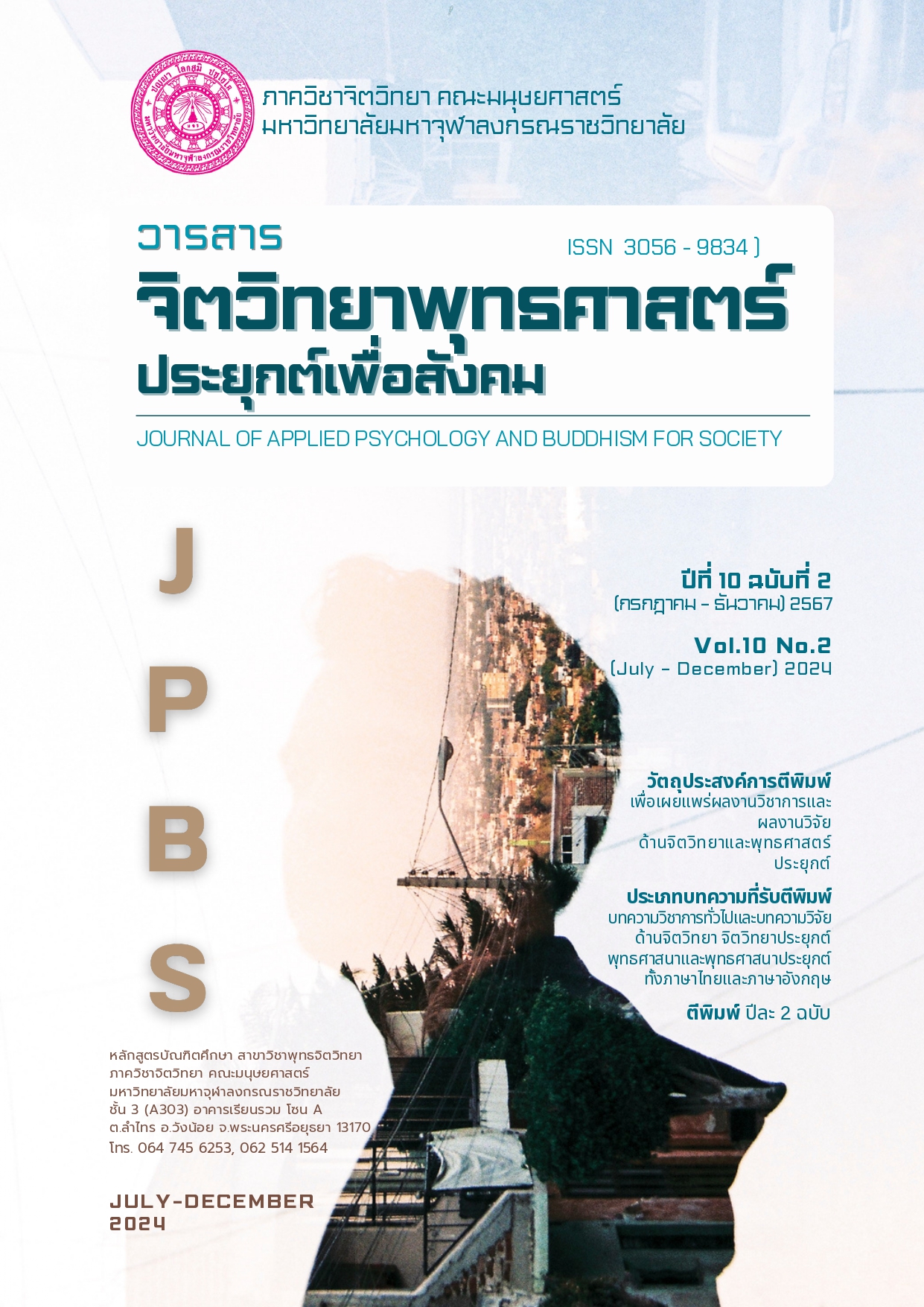The Practice of Vipassana Meditation according to Implications of Studying Buddhism and Modern Science
Keywords:
Vipassana, Meditation, Education, Buddhism, Modern SciencesAbstract
This research aims to: 1. study Vipassana meditation in the context of Buddhist education; 2. explore the relationship between Buddhism and modern sciences; and 3. investigate the connection between Vipassana meditation in Buddhist studies and modern scientific disciplines. The study employs a qualitative research method through in-depth interviews. The key informants include Vipassana meditation instructors, academic administrators, and scholars from universities, totaling 25 participants. Data were analyzed using content analysis derived from field studies.
The findings reveal that: 1. Meditation in Buddhism involves 40 techniques, and Buddhist universities at all levels-bachelor's, master's, and doctoral programs-incorporate meditation into their curricula. These programs commonly use the Four Foundations of Mindfulness (Satipatthana) as a framework, with specific practices like "rising and falling" meditation (noting the physical sensations of the abdomen) as a mechanism for cultivating mindfulness and human resource development, emphasizing physical and mental awareness. 2. The integration of Buddhism with modern sciences has proven effective in enhancing human resource development, medical science, and areas related to Vipassana meditation. Examples include Vipassana's impact on well-being, improving individual performance, and enhancing leadership skills through mindfulness practices. 3. The connection between Vipassana meditation in Buddhist studies and modern sciences is evident in studies such as "The Use of Acceptance and Commitment Therapy to Prevent the Rehospitalization of Psychotic Patients: A Randomized Controlled Trial" and "The Benefits of Being Present: Mindfulness and Its Role in Psychological Well-Being." These studies demonstrate the links between Buddhism or Vipassana meditation and psychology, human resource development, peacebuilding, and mental health and well-being.
References
นภาพัทธ์ งามบุษบงโสภิน และคณะ. (2565). กระบวนการทำงานร่วมกันระหว่างสมาธิกับปัญญาในการปฏิบัติกรรมฐาน. วารสารสันติศึกษาปริทรรศน์ มจร, 10(1), 126-141.
ทวีวัฒน์ ปุณฑริกวัฒน์. (2539). พุทธทาสภิกขุกับทฤษฎีธรรมิกสังคมนิยม. พุทธศาสน์ศึกษา(พฤษภาคม-สิงหาคม), 29-52.
ปมณฑ์ณัฐ จงวัฒนานุกูลกิจ และคณะ. (2563). รูปแบบพุทธจิตวิทยาเพื่อสร้างเสริมสุขภาวะทางปัญญาของจิตอาสาในกลุ่มผู้ปฏิบัติธรรม. วารสารสังคมศาสตร์และมานุษยวิทยาเชิงพุทธ วัดวังตะวันตก, 5(1), 183-196.
ผุสดี โตสวัสดิ์. (2562). การบำบัดรักษาโรคด้วยวิธีการปฏิบัติกรรมฐาน. วารสารปรัชญาปริทรรศน์, 24(2), 1-17.
พระครูปลัดไพรัช จนฺทสโร (กาญจนแก้ว). (2561). การแก้ปัญหาโรคความเครียดด้วยพุทธปรัชญาว่าด้วยมหาสติปัฏฐาน 4. วารสารมหาจุฬานาครทรรศน์, 5(2), 377-393.
พระธรรมกิตติวงศ์ (ทองดี สุรเตโช). (2548). พจนานุกรมเพื่อการศึกษาพุทธศาสน์ ชุด คำวัด. กรุงเทพฯ : วัดราชโอรสาราม.
พระปลัดสมภาร สมภาโร, พระธรรมวัชรบัณฑิต และประพันธ์ ศุภษร. (2564). ผลของการปฏิบัติวิปัสสนากรรมฐานต่อสุขภาพจิตของบุคคล. วารสารสันติศึกษาปริทรรศน์ มจร, 9(6), 2260-2271.
พระพรหมบัณฑิต. (2556). วิธีบูรณาการพระพุทธศาสนากับศาสตร์สมัยใหม่ Integrative method : Buddhism & Modern Sciences. สืบค้น 15 พฤษภาคม 2565 จาก https://www.mebmarket.com/index.php?action=BookDetails&book_id=15374
พระมหาชิต ฐานจิตฺโต และคณะ. (2561). การปฏิบัติและการสอบอารมณ์กรรมฐานตามหลักพระพุทธศาสนาเถรวาทในประเทศไทย. วารสารสันติศึกษาปริทรรศน์, 6(3), 1171-1181.
พระมหาไพฑูรย์ ปนฺตนนฺโท (วรรณบุตร). (2563). การบำบัดโรคซึมเศร้าด้วยการประยุกต์ใช้การปฏิบัติวิปัสสนากัมมัฏฐาน. สถาบันวิจัยญาณสังวร มหาวิทยาลัยมหามกุฏราชวิทยาลัย, 11(2), 99-110.
พระมหาวินัย วชิรเมธี. (2015). ศึกษาขณิกสมาธิในการปฏิบัติวิปัสสนาภาวนา ตามแนวมหาสติปัฏฐานสูตร. วารสารบัณฑิตศาสน์ บัณฑิตวิทยาลัย มหาวิทยาลัยมหามกุฏราชวิทยาลัย, 13(2), 76-84.
พระมหาวุฒิชัย วุฑฺฒิชโย. (2563). การศึกษาเปรียบเทียบรูปแบบการพัฒนาจิตของกรรมฐาน 5 สายในสังคมไทย. ธรรมธารา วารสารวิชาการทางพระพุทธศาสนา, 6(1), 5-50.
พระมหาหรรษา ธมฺมหาโส. (2565). พระพุทธศาสนากับวิทยาการสมัยใหม่: ตัวแบบวิธีวิทยาว่าด้วยพุทธบูรณาการและพุทธสหวิทยาการ. สืบค้น 15 พฤษภาคม 2565, จาก http://oldweb.mcu.ac.th/site/articlecontent_desc.php?article_id=1733&articlegroup_id=278
พระมหาอนันต์ อนุตฺตโร,บุญร่วม คําเมืองแสน และพระมหาพจน์ สุวโจ. (2564). การปฏิบัติกรรมฐานเพื่อบำบัดความเครียด. วารสารมนุษยศาสตร์และสังคมศาสตร์มหาวิทยาลัยเอเชียอาคเนย์, 5(2), 329-342.
พุธิธาดา เดชพิทักษ์. (2562). การพัฒนาโมเดลความสัมพันธ์เชิงสาเหตุของความสุขจากการวิปัสสนากรรมฐานตามแนวพุทธจิตวิทยา. วารสารบัณฑิตศึกษาปริทรรศน์, 15(2), 93-100.
ภุชง ฝูงชมเชย. (2559). การปฏิบัติวิปัสสนากรรมฐานเป็นการฟื้นฟูสมรรถภาพร่างกายดีที่สุด. วารสารมหาวิทยาลัยราชภัฎลำปาง, 5(1), 124-130.
ริชาร์ด แมนดิอัส ริค แฮนสัน. (2557). สมองแห่งพุทธะ [Buddha's Brain: The Practical Neuroscience of Happiness, Love, and Wisdom Buddha] (ณัชร สยามวาลา ผู้แปล). กรุงเทพฯ : สำนักพิมพ์อมรินร์ธรรมะ.
ลัดดา เฉลิมกาญจนา, พระธรรมวัชรบัณฑิต และ ขันทอง วัฒนะประดิษฐ์. (2565). รูปแบบการให้คำปรึกษาเด็กและเยาวชนสู่วิถีสันติสุขในศาลเยาวชนและ ครอบครัวกลาง. วารสารสันติศึกษาปริทรรศน์ มจร, 10(1), 1-15.
วราลี ตั้งวินิต. (2562). แนวทางบูรณาการพุทธบำบัดเชิงนิเวศเพื่อกลุ่มโรคไม่ติดต่อเรื้อรัง (NCDs). วารสารบัณฑิตศึกษาปริทรรศน์, 15(เพิ่มเติม), 1-14.
วราวุฒิ บูลกุล, พระธรรมวัชรบัณฑิต และ ขันทอง วัฒนะประดิษฐ์. (2564). พุทธสันตินวัตกรรมการมีส่วนร่วมเพื่อพัฒนาองค์กรสันติสุขของธุรกิจการให้บริการ. วารสารสันติศึกษาปริทรรศน์ มจร, 9(7), 1-15.
สมเด็จพระพุทธโฆษาจารย์ (ป.อ.ปยุตฺโต). (2535). พุทธศาสนาในฐานะเป็นรากฐานของวิทยาศาสตร์. กรุงเทพฯ: มูลนิธิพุทธธรรม.
สมภาร พรมทา. (2565). พระพุทธศาสนากับวิทยาการสมัยใหม่. สืบค้น 15 พฤษภาคม 2567, จาก https://www.youtube.com/watch?v=396YqEppi1g
อำพล บุดดาสาร และ พระมหาชิต ฐานชิโต. (2559). พุทธวิธีการสอนให้บรรลุธรรมตามลำดับวิปัสสนาญาณแก่ผู้ฟังและผู้ปฏิบัติธรรม. วารสาร มจร บาฬีศึกษาพุทธโฆสปริทรรศน์, 2(1), 59-74.
Bach P, et al. (2002). The Use of Acceptance and Commitment Therapy to Prevent the Rehospitalization of Psychotic Patients: A Randomized Controlled Trial. Journal of Consulting and Clinical Psychology, 70(5), 1129-1139.
Brown KW, et al. (2003). The Benefits of Being Present: Mindfulness and Its Role in Psychological Well-Being. Journal of Personality and Social Psychology, 84(4), 822–848.
Hanson, R. and Mendius, R. (2009). Buddha’s Brain : the practical neuroscience of happiness, love, and wisdom. Oakland: New Harbinger Publications.
Hayes SC, et al., eds. (2004). Mindfulness and Acceptance: Expanding the Cognitive-Behavioral Tradition. Guilford Press.
Kabat-Zinn J, et al. (1992). Effectiveness of a Meditation-Based Stress Reduction Program in the Treatment of Anxiety Disorders. American Journal of Psychiatry, 149(7),936-943.
Teasdale JD, et al. (2000). Prevention of Relapse/Recurrence in Major Depression by Mindfulness-Based Cognitive Therapy. Journal of Consulting and Clinical Psychology, 68(4), 615–623.
Downloads
Published
How to Cite
Issue
Section
Categories
License
Copyright (c) 2024 Journal of Applied Psychology and Buddhism for Society

This work is licensed under a Creative Commons Attribution-NonCommercial-NoDerivatives 4.0 International License.





